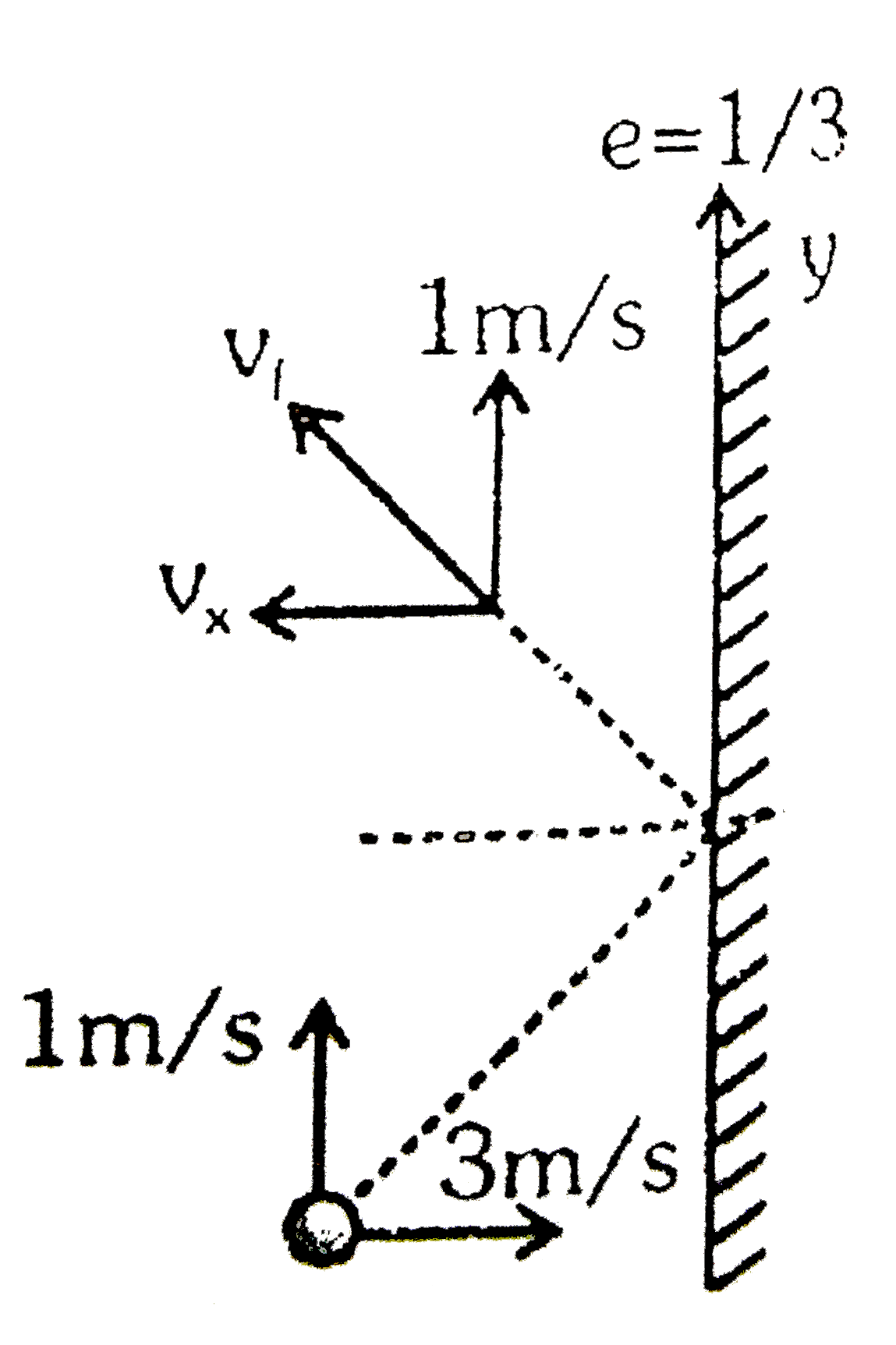A smooth sphere is moving on a horizontal surface with velocity vector 3ˆi+ˆj immediately before it hits a vertical wall. The wall is parallel to the vector ˆj and the coefficient of restitution between the wall and sphere is 13. The velocity vector of the sphere after it hits the wall is :-Solution in Gujrati
ˆi+ˆj
3ˆi−13ˆj
−ˆi+ˆj
ˆi−ˆj
The correct Answer is:C
eRate of seperationRate of approach
13=vx3
vx=1
vf=−ˆi+ˆj

Topper's Solved these Questions
- CENTRE OF MASSBOOK - ALLEN CHAPTER - CENTRE OF MASSEXERCISE - EXERCISE-II
43 Videos
- CENTRE OF MASSBOOK - ALLEN CHAPTER - CENTRE OF MASSEXERCISE - EXERCISE-III
41 Videos
- CENTRE OF MASSBOOK - ALLEN CHAPTER - CENTRE OF MASSEXERCISE - EXERCISE-V B
19 Videos
- BASIC MATHEMATICS USED IN PHYSICS &VECTORS BOOK - ALLEN CHAPTER - BASIC MATHEMATICS USED IN PHYSICS &VECTORS EXERCISE - EXERCISE-IV ASSERTION & REASON
11 Videos
- ELASTICITY, SURFACE TENSION AND FLUID MECHANICSBOOK - ALLEN CHAPTER - ELASTICITY, SURFACE TENSION AND FLUID MECHANICSEXERCISE - Exercise 5 B (Integer Type Questions)
3 Videos
Similar Questions
Two particle A and B start moving due to their mutual interaction only. If at any tiem 't', →aA and →aB are their respective accelerations, →vA and →vB are their respective velocities, and upto that time WA and WB are the work done on A and B respectively by the mutual force, mA and mB are their masses respectively, then which of the following is alwys correct.
View SolutionA particle of mass m, kinetic energy K and momentum p collision head on elastically with another particle of mass 2m at rest. After collision. :
Column IColumn II(A)Momentum of first particle(p)3/4p(B)Momentum of second particle(q)−K/9(C)Kinetic energy of first particle(r)−p/3(D)Kinetic energy of second particle(s)8K9None
View SolutionTwo particles of masses m1 and m2 in projectile motion have velocities →v1 and →v2 , respectively , at time t=0. They collide at time t0. Their velocities become →v'1 and →v'2 at time 2t0 while still moving in air. The value of ∣∣∣(m1→v'1+m2→v'2)−(m1→v1+m2→v2)∣∣∣
View SolutionAssertion: If the initial and final positions coincide, the displacement is a null vector.
Reason: A physical quantity can not be called a vector, if its magnitude is zero.
View SolutionTwo soap bubbles A and B are kept in a closed chamber where the air is maintained at pressure 8N/m2.The radii of bubbles A and B are 2cm and 4cm, respectively. Surface tension of the soap-water used to make bubbles is 0.04N/m. Find tha ratio nB/nA, where nA and nB are the number of moles of air in bubbles A and B, respectively. [Neglect the effect of gravity.]
View SolutionA smooth sphere is moving on a horizontal surface with velocity vector 2ˆi+2ˆj immediately before it hits a vertical wall. The wall is parallel to ˆj and the coefficient of restitution of the sphere and the wall is e=12. Find the velocity of the sphere after it hits the wall?
View SolutionA smooth sphere is moving on a horizontal surface with velocity vector 2hati+2hatj immediately before it hits a vertical wall. The wall is parallel to hatj vector and the coefficient of restitution between the sphere and the wall is e = 1//2 . The velocity vector of the sphere after it hits the wall is
View SolutionThe velocity vector of a sphere after it hits a vertical wall which is pallel to hatj is (-hati + 3hatj) on a smooth horizontal surface. The coefficient of restitution between ball and wall is (1//2) . Final the velocity vector of sphere immediately before collision.
View SolutionA small sphere of mass 1 kg is moving with a velocity (6ˆi+ˆj)ms−1. It hits a fixed smooth wall and rebound with velocity (4ˆi+ˆj)ms−1. The coefficient of restitution between the sphere and the wall is
View SolutionA smooth sphere of mass m is moving on a horizontal plane with a velocity (3ˆi+ˆj) . It collides with smooth a vertical wall which is parallel to the vector ˆj . If coefficient of restitution e=12 then impulse that acts on the sphere is
View SolutionA smooth sphere is moving on horizontal surface with a velocity vector (2→i+2→j)m/s immediately before it hit a vertical wall. The wall is parallel to vector →j and coefficient of restitution between the sphere and the wall is e = 1/2. The velocity of the sphere after it hits the wall is
View SolutionA sphere of mass 1kg is moving with a velocity 4ˆi−ˆj. It hits a wall and rebounds with velocity ˆi+3ˆj. The coefficient of restitution between the sphere and the wall is
View SolutionA smooth sphere of mass m is moving on a horizontal plane with a velocity 3ˆi+ˆj when t collides with a vertical wall which is parallel to the vector ˆj. If the coefficiet of restitution between the sphere and the wall is 1/2
The velocity of the sphere after impact is
View SolutionA smooth sphere of mass m is moving on a horizontal plane with a velocity 3ˆi+ˆj when t collides with a vertical wall which is parallel to the vector ˆj. If the coefficiet of restitution between the sphere and the wall is 1/3
The loss in kinetic energy caused by the impact is
View SolutionA smooth sphere of mass m is moving on a horizontal plane with a velocity 3ˆi+ˆj when t collides with a vertical wall which is parallel to the vector ˆj. If the coefficiet of restitution between the sphere and the wall is 1/4
The impulse ˆj that acts on the sphere is
View SolutionA smooth ball before hitting a vertical wall (2hat(i) +2hat(j)) is moving at a velocity of m / s. If the wall hat(j) Is parallel to the axis and the elasticity coefficient of the collision is e = 1/2, then the velocity after the collision will be -
View Solution
